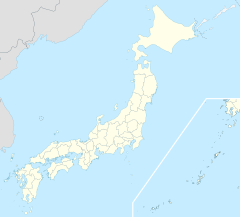railroad.wikisort.org - Station
Ōga Station (大神駅, Ōga-eki) is a railway station on the Nippō Main Line operated by Kyūshū Railway Company in Hiji, Ōita, Japan.[1][2]
Ōga Station 大神駅 | |
|---|---|
 Ōga Station in August 2008 | |
| General information | |
| Location | Hiji, Ōita Japan |
| Coordinates | 33°23′01″N 131°34′30″E |
| Operated by | |
| Line(s) | ■ Nippō Main Line |
| Distance | 103.3 km from Kokura |
| Platforms | 1 island platform |
| Tracks | 2 |
| Construction | |
| Structure type | At grade |
| Disabled access | No - level crossing to platform has steps |
| Other information | |
| Status | Staffed ticket window (outsourced) |
| Website | Official website |
| History | |
| Opened | 1 June 1952 |
| Passengers | |
| FY2016 | 481 daily |
| Rank | 248th (among JR Kyushu stations) |
| Location | |
 Ōga Station Location within Japan | |
Lines
The station is served by the Nippō Main Line and is located 103.3 km from the starting point of the line at Kokura.[3]
Layout
The station consists of an island platform serving two tracks at grade. The station building is a modern concrete structure which houses an enclosed waiting room and a staffed ticket window. Access to the island platform is by means of a level crossing with steps at both ends.[2][3]
Management of the station has been outsourced to the JR Kyushu Tetsudou Eigyou Co., a wholly owned subsidiary of JR Kyushu specialising in station services. It staffs the ticket booth which is equipped with a POS machine but does not have a Midori no Madoguchi facility.[4][5]
Adjacent stations
| « | Service | » | ||
|---|---|---|---|---|
| Nippō Main Line | ||||
| Kitsuki | Local | Hiji | ||
History
Japanese National Railways (JNR) opened the station on 1 June 1952 as an additional station on the existing track of the Nippō Main Line. With the privatization of JNR on 1 April 1987, the station came under the control of JR Kyushu.[6]
Passenger statistics
In fiscal 2016, the station was used by an average of 481 passengers daily (boarding passengers only), and it ranked 248th among the busiest stations of JR Kyushu.[7]
See also
- List of railway stations in Japan
References
- "JR Kyushu Route Map" (PDF). JR Kyushu. Retrieved 23 February 2018.
- "大神" [Ōga]. hacchi-no-he.net. Retrieved 29 April 2018.
- Kawashima, Ryōzō (2013). 図説: 日本の鉄道 四国・九州ライン 全線・全駅・全配線・第4巻 福岡エリア [Japan Railways Illustrated. Shikoku and Kyushu. All lines, all stations, all track layouts. Volume 4 Fukuoka Area] (in Japanese). Kodansha. pp. 44, 80. ISBN 9784062951630.
- "大分支店内各駅" [Stations within the Ōita Branch]. JRTE website. Retrieved 9 April 2018.
- "大神" [Ōga Station]. jr-mars.dyndns.org. Retrieved 29 April 2018. See images of tickets sold.
- Ishino, Tetsu; et al., eds. (1998). 停車場変遷大事典 国鉄・JR編 [Station Transition Directory – JNR/JR] (in Japanese). Vol. II. Tokyo: JTB Corporation. p. 752. ISBN 4-533-02980-9.
- "駅別乗車人員上位300駅(平成28年度)" [Passengers embarking by station - Top 300 stations (Fiscal 2016)] (PDF). JR Kyushu. 31 July 2017. Archived from the original (PDF) on 1 August 2017. Retrieved 3 March 2018.
External links
- Official website (in Japanese)
Другой контент может иметь иную лицензию. Перед использованием материалов сайта WikiSort.org внимательно изучите правила лицензирования конкретных элементов наполнения сайта.
WikiSort.org - проект по пересортировке и дополнению контента Википедии